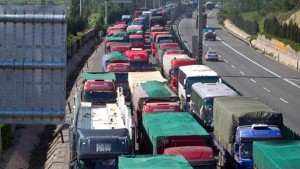
China's reliance on foreign oil has increased dramatically due to the rapid increase in vehicles on the roads.
The rapid growth of new vehicle sales in China has led to significant increases in oil demand and oil imports, raised the price of petroleum around the world and prompted the Chinese government to offer big subsidies to motorists using electric vehicles.
Consumption of gasoline in China more than doubled from roughly 900,000 barrels per day (bbl/d) in 2003 to more than 2 million bbl/d in 2013, extending a trend of significant growth in China’s transportation sector since the 1990s.
Automakers in China sold more than 20 million vehicles last year, including more than 550,000 in the capital city of Beijing where sales are regulated a license plate lottery that is designed to curb some of the enthusiasm for cars among China’s legions of consumers.
About 50% of the all the vehicles sold in China are compact or C-Class vehicle according to Yale Zhang, an analyst who has followed the development of the Chinese auto industry.
Increasing oil demand requires China to import more petroleum from other countries, and since 2009, China has been importing more than half of its petroleum needed, which has become a growing source of concern for Chinese political leaders, who are ratcheting up fuel-economy regulations.
Global automakers report that China now has some of the world’s toughest fuel-economy regulations. Under the Energy Saving and New Energy Vehicle Plan for 2012 to 2020 released in 2012, average passenger car fuel economy is targeted to increase to 34 miles per gallon by 2015 and 47 miles per gallon by 2020, according to the EIA analysis.
In response to growing oil imports, the Chinese government is also adopting a broad range of policies to promote the sales of alternative-fuel vehicles, the EIA report noted.
In its 12th, and current, Five-Year Plan, the Chinese government also launched a new strategy to promote new energy vehicles (NEV), or vehicles that are partially or fully powered by electricity, and to support its domestic automobile industry to mass-produce NEVs.
The plan approved by Chinese government calls investing an estimated $15 billion in alternative-fuel vehicles during the next 10 years. The national target for cumulative production and sales of electric and plug-in hybrid vehicles is 500,000 units by 2015. However, NEV target for 2020, originally set at 5 million vehicles, was recently scaled back to 1 million vehicles, the EIA noted.
To meet NEV penetration targets, to boost consumer demand, and to make alternative-fuel vehicles more affordable, the Chinese government has been offering many financial incentives, including some $4 billion allocated for energy-saving products, primarily NEVs and household appliances.
Additionally, in 2012 the Chinese Ministry of Finance announced it would provide annual subsidies up to $324 million to support NEV manufacturing. In September 2013, the government announced additional subsidies that will support the growth of new energy vehicle ownership through 2015.
For electric vehicles, subsidies from the central government are often matched by local subsidies. For example, in Beijing, the central government subsidy of $9,700 is matched by a subsidy of equal amount from the city of Beijing where electric charging stations have begun to appear.
(Aston Martin reveals product plans, hopes for profit by 2016. For more, Click Here.)
Many other cities also offer considerable subsidies. For example, the Shenzhen government offers one of the highest subsidies for electric vehicles in the country – $19,400 per passenger vehicle – reducing the price of such vehicles by more than half.
In addition to financial incentives, some cities offer other incentives, including free license plates for NEVs and exemptions from vehicle license plate quota systems. For example, Shanghai (where a license plate can cost as much or more than an entry-level domestically manufactured car) offered free license plates for 20,000 electric vehicles purchased before the end of 2013.
(Click Here for details about another GM recall.)
Guangzhou offers 12,000 free plates allocated by lottery, and Beijing offers electric vehicles an exemption from the vehicle license lottery, which prospective owners of gasoline-fueled automobiles are required to enter.
(To see more about GM moving Spark EV battery production in-house, Click Here.)
Despite many incentives, electric vehicles sales to date have been minimal. NEV sales account for less than 1% of total vehicle sales in China, which in 2013 was the world’s largest vehicle sales market. In fact, China’s held that title for the last five years.
As in the United States and Western Europe, some of the reasons behind low sales of NEVs to date are high vehicle costs despite government subsidies, inadequate charging infrastructure, limited driving range when compared to conventional internal combustion engine vehicles, lack of a national industry standard for charging connectors, consumer education and acceptance of the new technology.
